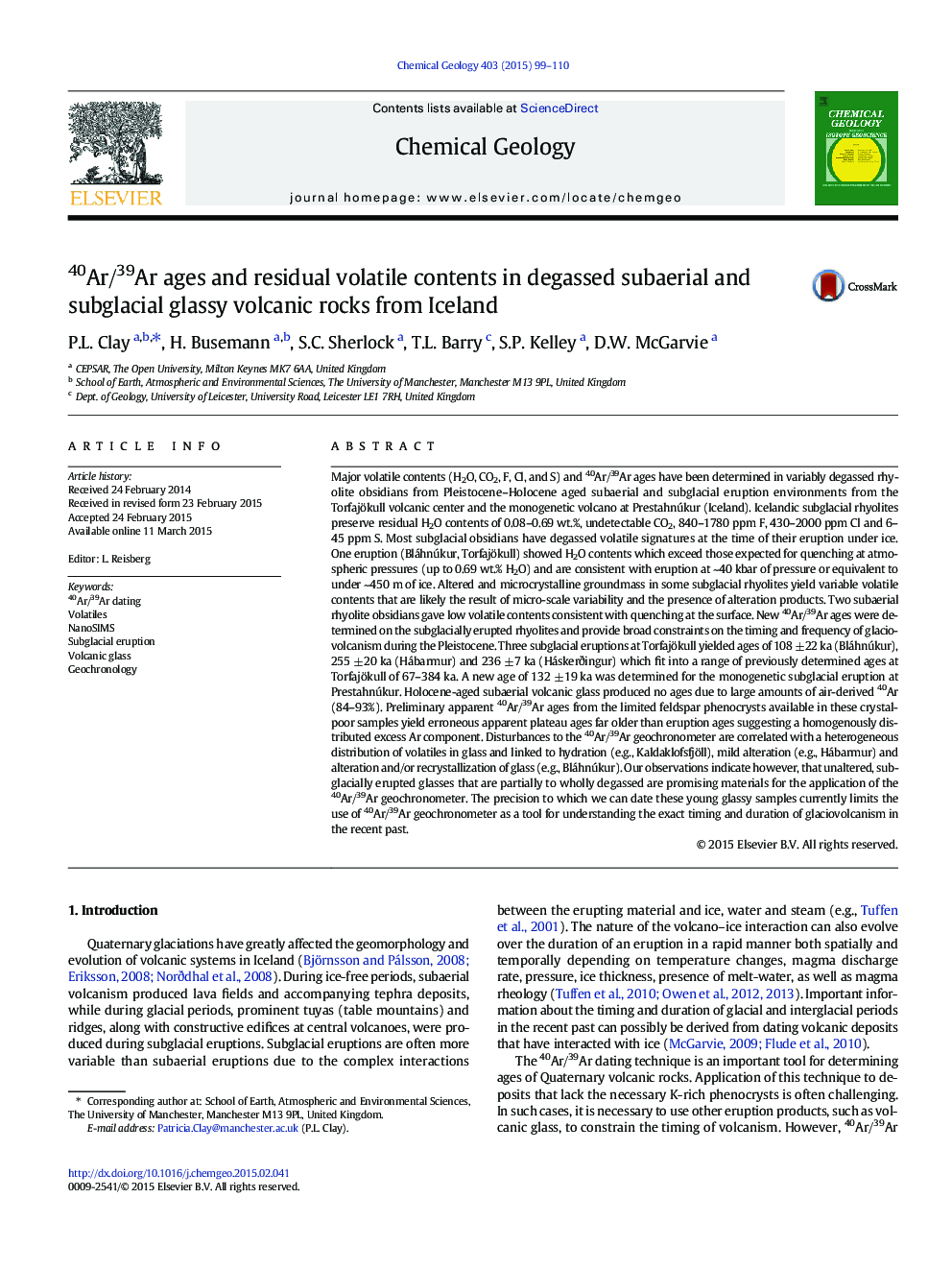| کد مقاله | کد نشریه | سال انتشار | مقاله انگلیسی | نسخه تمام متن |
|---|---|---|---|---|
| 6436419 | 1637570 | 2015 | 12 صفحه PDF | دانلود رایگان |

- New 40Ar/39Ar ages have been determined for subglacially erupted glasses in Iceland.
- Alteration, hydration and mass-fractionation likely prevented age determination in some samples.
- These disturbances are linked to micro-scale variability in measured volatile contents.
- Water contents in fresh glass can be used to estimate ice-thickness.
Major volatile contents (H2O, CO2, F, Cl, and S) and 40Ar/39Ar ages have been determined in variably degassed rhyolite obsidians from Pleistocene-Holocene aged subaerial and subglacial eruption environments from the Torfajökull volcanic center and the monogenetic volcano at Prestahnúkur (Iceland). Icelandic subglacial rhyolites preserve residual H2O contents of 0.08-0.69 wt.%, undetectable CO2, 840-1780 ppm F, 430-2000 ppm Cl and 6-45 ppm S. Most subglacial obsidians have degassed volatile signatures at the time of their eruption under ice. One eruption (Bláhnúkur, Torfajökull) showed H2O contents which exceed those expected for quenching at atmospheric pressures (up to 0.69 wt.% H2O) and are consistent with eruption at ~40 kbar of pressure or equivalent to under ~450 m of ice. Altered and microcrystalline groundmass in some subglacial rhyolites yield variable volatile contents that are likely the result of micro-scale variability and the presence of alteration products. Two subaerial rhyolite obsidians gave low volatile contents consistent with quenching at the surface. New 40Ar/39Ar ages were determined on the subglacially erupted rhyolites and provide broad constraints on the timing and frequency of glacio-volcanism during the Pleistocene. Three subglacial eruptions at Torfajökull yielded ages of 108 ±22 ka (Bláhnúkur), 255 ±20 ka (Hábarmur) and 236 ±7 ka (Háskerðingur) which fit into a range of previously determined ages at Torfajökull of 67-384 ka. A new age of 132 ±19 ka was determined for the monogenetic subglacial eruption at Prestahnúkur. Holocene-aged subaerial volcanic glass produced no ages due to large amounts of air-derived 40Ar (84-93%). Preliminary apparent 40Ar/39Ar ages from the limited feldspar phenocrysts available in these crystal-poor samples yield erroneous apparent plateau ages far older than eruption ages suggesting a homogenously distributed excess Ar component. Disturbances to the 40Ar/39Ar geochronometer are correlated with a heterogeneous distribution of volatiles in glass and linked to hydration (e.g., Kaldaklofsfjöll), mild alteration (e.g., Hábarmur) and alteration and/or recrystallization of glass (e.g., Bláhnúkur). Our observations indicate however, that unaltered, subglacially erupted glasses that are partially to wholly degassed are promising materials for the application of the 40Ar/39Ar geochronometer. The precision to which we can date these young glassy samples currently limits the use of 40Ar/39Ar geochronometer as a tool for understanding the exact timing and duration of glaciovolcanism in the recent past.
Journal: Chemical Geology - Volume 403, 18 May 2015, Pages 99-110